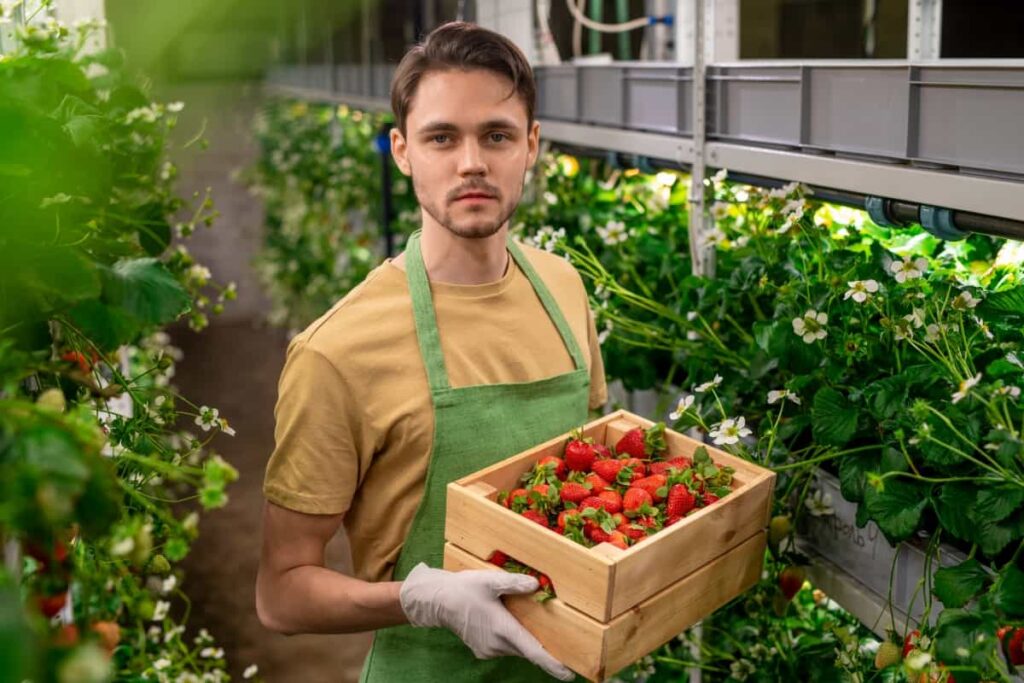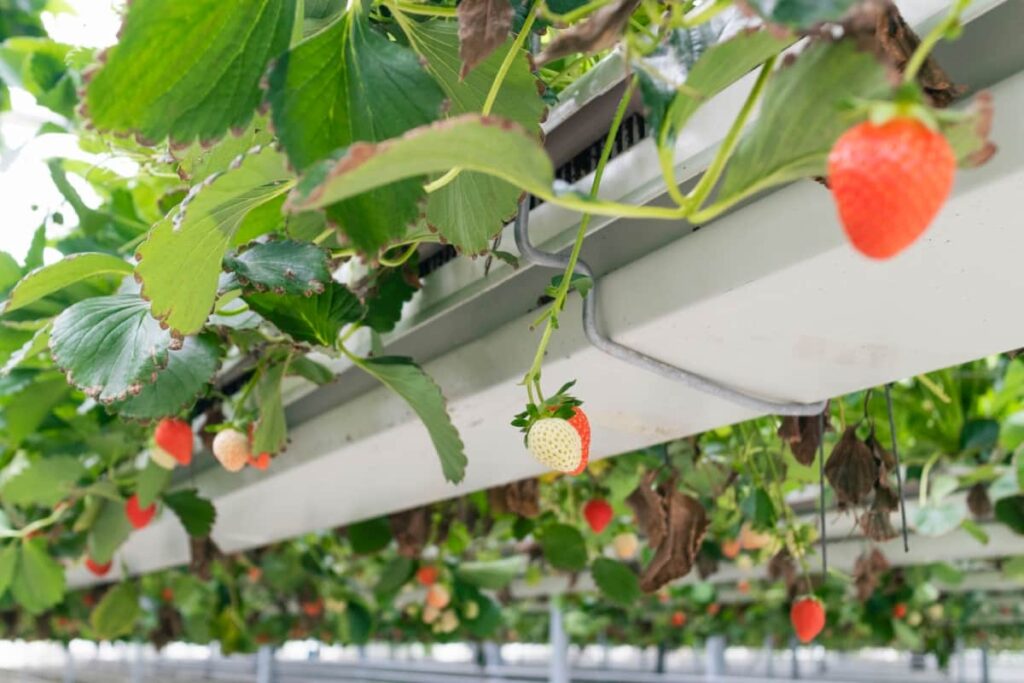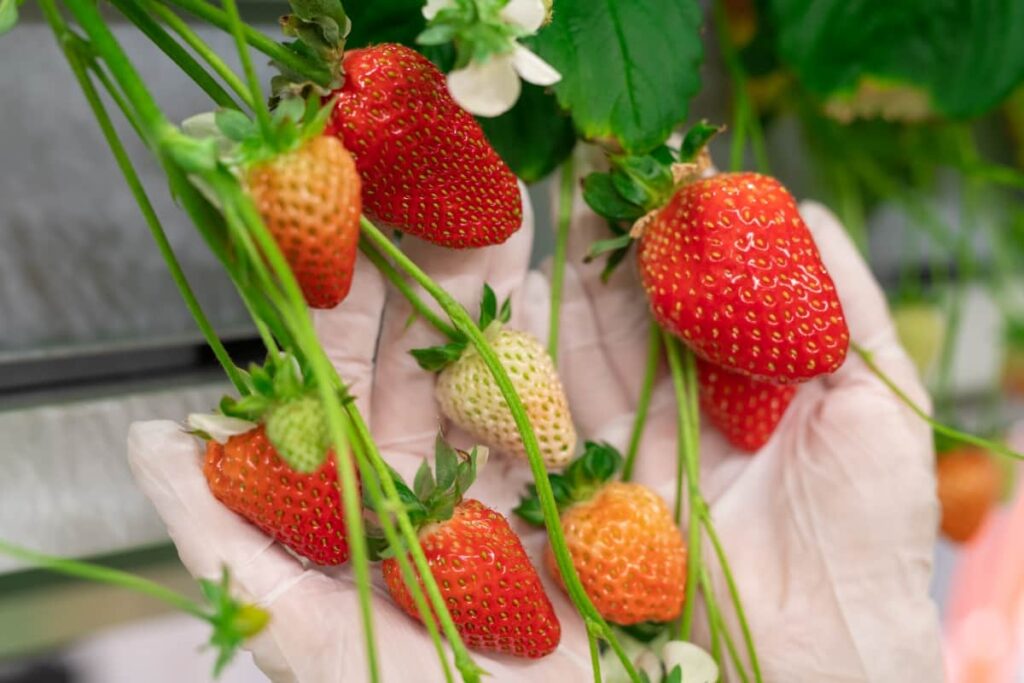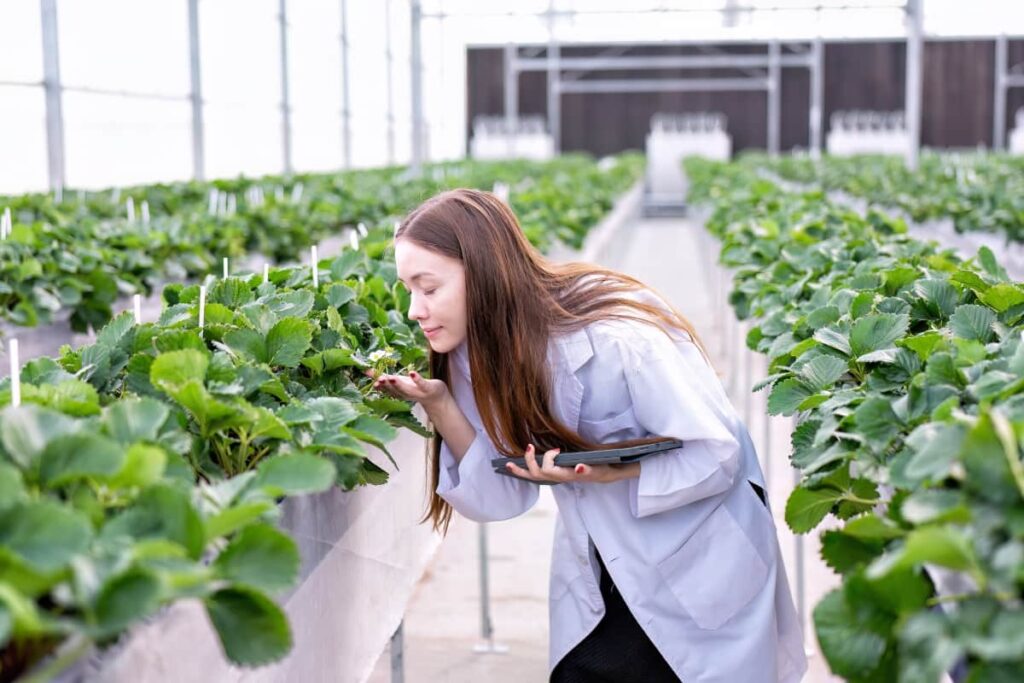Hydroponics refers to growing plants where the roots are submerged in a nutrient-rich water solution instead of soil. This technique allows for precise control over the plant’s environment, including pH levels, nutrient concentrations, and water availability. By providing plants with direct access to essential nutrients, hydroponics often results in faster growth rates and higher hydroponic strawberry yields compared to traditional soil-based farming methods.
Benefits of Strawberry Hydroponic Farming
- Growing strawberries hydroponically enables year-round production in controlled environments, ensuring a consistent supply of fresh strawberries regardless of seasonal variations.
- Hydroponic strawberry systems require significantly less water compared to traditional farming methods, making them more environmentally sustainable.
- Moreover, by eliminating the need for soil, hydroponics minimizes soil-borne diseases and pests, resulting in healthier plants and higher yields.
- Hydroponic strawberry farming can be tailored to suit various space constraints, making it accessible to urban growers and hobbyists alike.

Understanding Hydroponic Systems
Types of Hydroponic Systems for Strawberries
Deep Water Culture (DWC)
In DWC, plants are suspended in nutrient-rich water with their roots submerged. This continuous immersion ensures constant access to essential nutrients and oxygen. DWC is straightforward, making it suitable for beginners, and its simplicity makes it an excellent choice for growing strawberries.
Nutrient Film Technique (NFT)
NFT involves a thin film of nutrient-rich water flowing over the roots, providing a consistent supply of nutrients. This system is efficient in water usage and allows for optimal nutrient absorption. NFT is well-suited for strawberries due to its ability to support delicate root systems.
Ebb and Flow
Ebb and Flow, or flood and drain, involves periodically flooding the growing medium with nutrient solution and then draining it. This cyclical process ensures adequate oxygenation while delivering nutrients directly to the roots. It provides flexibility for growers to adapt to specific strawberry cultivation needs.
Choosing the Right System for Strawberries
Selecting the appropriate hydroponic system for strawberries depends on factors like available space, resources, and desired yield. Consideration must be given to the specific requirements of strawberry plants, such as root sensitivity and growth patterns. Deep Water Culture is user-friendly, the Nutrient Film Technique offers efficiency, and Ebb and Flow provide versatility.
Getting Started with Hydroponic Strawberries
Equipment and Supplies Needed
For Hydroponic strawberries farming, You’ll require a suitable Hydroponic strawberry kit system (such as Deep Water Culture, Nutrient Film Technique, or Ebb and Flow), a nutrient solution specifically formulated for strawberries, a pH testing kit, a growing medium (like perlite or coconut coir), net pots or baskets for plant support, LED grow lights (if growing indoors), a reservoir for nutrient solution, and a reliable water pump and timer for automated irrigation.
Setting Up Your Hydroponic System
Begin by assembling your chosen hydroponic strawberry tower according to manufacturer instructions. Ensure proper installation of pumps, tubing, and any supporting structures. Prepare the nutrient solution by following the manufacturer’s recommendations and adjust the pH to the optimal range for strawberries (around 5.5 to 6.5).
Place the strawberry plants into the growing medium-filled net pots or baskets and position them within the system. Fill the reservoir with the nutrient solution, set up the irrigation schedule, and monitor environmental conditions regularly to ensure optimal growth.
Selecting Strawberry Varieties
Best Strawberry Varieties for Hydroponics
Some best strawberries for hydroponics include ‘Albion,’ prized for its large, flavorful berries and disease resistance; ‘Seascape,’ known for its everbearing habit and excellent flavor; and ‘Tristar,’ a reliable variety with a sweet-tart taste and high productivity. These hydroponic strawberry varieties perform well in hydroponic systems, producing abundant harvests of quality fruit throughout the growing season.
Considerations for Variety Selection
When selecting strawberry varieties for hydroponics, consider factors such as growth habit, flavor profile, and intended use. Additionally, consider disease resistance and tolerance to environmental stressors to ensure successful cultivation.
In case you missed it: Vertical Strawberry Farming: A New Way to Increase Your Income and Yield

Nutrient Solutions and pH Management
Essential Nutrients for Strawberries
Strawberries need a balanced supply of essential nutrients to thrive in hydroponic systems. Key hydroponic strawberry nutrients include nitrogen, phosphorus, potassium, calcium (Ca), magnesium (Mg), sulfur (S), iron, manganese, zinc, copper (Cu), boron (B), and molybdenum (Mo). These nutrients are vital in various plant functions, such as growth, flowering, fruit development, and disease resistance.
pH and EC Levels: Monitoring and Adjustments
Hydroponic strawberry care includes maintaining proper pH and electrical conductivity (EC) levels is crucial for maximizing nutrient uptake and preventing nutrient deficiencies. Regularly monitor pH levels using a reliable pH meter and adjust them within the optimal range of 5.5 to 6.5 for strawberries. Additionally, measure EC levels to ensure the nutrient solution’s strength is appropriate for the plant’s growth stage. Adjustments should be made by adding pH-up or pH-down solutions and diluting or concentrating the nutrient solution as needed.
Lighting and Environmental Control
Lighting Requirements for Hydroponic Strawberries
Strawberries typically require a minimum of 8-12 hours of direct or indirect sunlight equivalent per day for optimal growth and fruit production. In indoor hydroponic strawberries setups, high-quality LED grow lights with a spectrum tailored to the plant’s needs are recommended. Position lights to ensure uniform coverage and adjust intensity based on the growth stage of the plants.
Temperature and Humidity Control
Ideal temperatures for strawberries range between 15°C to 27°C during the day and slightly cooler at night. Proper ventilation and air circulation to prevent heat buildup and humidity-related issues such as mold or mildew. Humidity levels should be kept around 60-80% to support healthy plant growth and minimize stress. Utilize fans, dehumidifiers, and HVAC systems as needed to create an ideal environment for thriving hydroponic strawberry crops.
Planting and Propagation
Seed Starting vs. Using Runners
In hydroponic strawberry cultivation, growers have two primary options for propagation: seed starting or using runners. While seed starting offers more control over genetic diversity and disease management, using runners typically results in faster establishment and earlier fruiting. Growers should select the method that best suits their preferences, resources, and specific growing conditions.
Transplanting Young Plants into the Hydroponic System
When transplanting young strawberry plants into the hydroponic system, ensure they are well-rooted and free from any signs of disease or pests. Carefully remove plants from their nursery containers and gently rinse the roots to remove excess growing medium. Place the plants into net pots or baskets filled with the chosen hydroponic growing medium, ensuring the roots are adequately covered. Position the pots or baskets within the hydroponic system, ensuring proper spacing to facilitate airflow and light penetration.
Daily and Weekly Maintenance
Monitoring Nutrient Solutions and pH Levels
Measure pH levels daily and make adjustments using pH-up or pH-down solutions to keep the pH within the recommended range for strawberries (5.5 to 6.5). Weekly, refresh the nutrient solution completely to prevent nutrient imbalances and buildup of salts. Conduct regular checks for any signs of nutrient deficiencies or excesses and address them promptly to support healthy plant growth and fruit development.
Pruning and Supporting Plants
Regularly remove dead or yellowing leaves, as well as runners that divert energy away from fruit production. Pinch off excessive runners to redirect the plant’s energy into fruiting. Provide support for heavy fruit clusters using trellises or stakes to prevent breakage and ensure proper airflow around the plants.
In case you missed it: Strawberry Growing Information Guide

Pest and Disease Management
Common Pests and Diseases in Hydroponic Strawberries
Common pests include spider mites, aphids, thrips, and whiteflies, which can infest plants and cause damage to foliage and fruit. Additionally, diseases such as powdery mildew, gray mold (Botrytis), and root rot (Pythium) pose significant threats to hydroponic strawberry crops, potentially leading to reduced yields and plant health.
Organic and Chemical Control Methods
Organic hydroponic strawberries pest control includes beneficial insects like ladybugs and predatory mites to control pest populations, as well as neem oil or insecticidal soap sprays for pest management. Additionally, cultural practices such as maintaining proper plant spacing and sanitation help prevent disease spread. Chemical control involves the use of synthetic pesticides and fungicides, but their use should be approached cautiously to minimize environmental impact and adhere to regulations.
Harvesting and Post-Harvest Handling
When to Harvest Strawberries
Generally, strawberries are ready for harvest when they reach full color, typically red or, depending on the variety and firmness. Harvesting should ideally be done in the morning when temperatures are cooler to preserve the fruit’s freshness. Carefully pluck or cut ripe strawberries from the plant, being mindful not to damage the delicate fruit or nearby foliage. Regular harvesting encourages continuous fruit production throughout the growing season.
Post-Harvest Storage and Packaging
After harvesting, handle strawberries with care to minimize bruising and prolong shelf life. Remove any damaged or overripe berries to prevent spoilage. Store strawberries in a cool, humid environment to maintain freshness. For short-term storage, please place them in a single layer in shallow containers lined with paper towels to absorb excess moisture.
Alternatively, strawberries can be stored in perforated plastic bags in the refrigerator for a few days. When packaging for sale or distribution, use clean, ventilated containers to prevent mold growth and maintain air circulation.
In case you missed it: Best Fertilizer for Hydroponic Strawberries: Boost Your Yield and Flavor with These Nutrient Solutions

Conclusion
In conclusion, this Hydroponic strawberry guide equips beginners with the knowledge needed to embark on successful hydroponic strawberry cultivation. By following the guidance provided on planting, maintenance, and post-harvest handling, growers can harness the benefits of hydroponics to produce flavorful strawberries year-round. Happy growing!
- Management Pests and Diseases in Your Cotton Field
- Sheep Farming Business Plan for Beginners
- Aquaponic Farming at Home: A Step-By-Step Guide
- Profitable Village Farming Business Ideas in 2024
- High-Yield Aquaculture: Fast-Growing Fish for Farming
- Effective Fish Pond Construction Techniques for Beginners
- Irrigation and Water Management in Pineapple Farming
- Blossom to Harvest: Mastering Flowering and Pollination in Papaya Farming
- Pig Fattening Essentials: From Selection to Sale for Beginners
